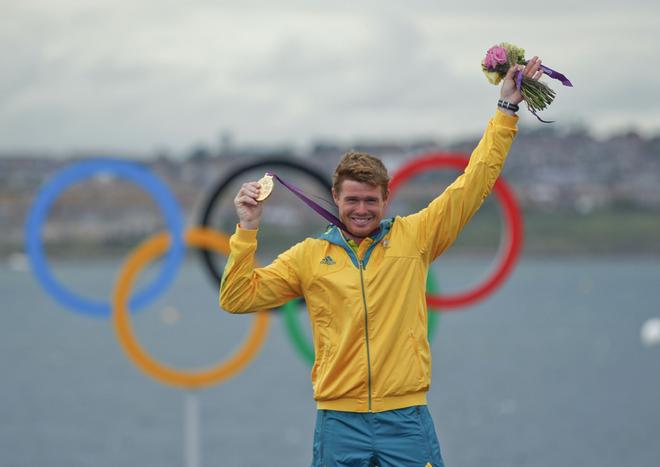Olympic Gold or Auld Mug shine?—Sailing news from the U.S. and beyond
by David Schmidt, Sail-World USA Editor on 3 Sep 2015

Tom Slingsby with his Gold medal at the 2012 Olympics Photo on Edition
Ever since I was a kid, I have been keenly aware of sailing’s three great prizes: the America’s Cup, Olympic Gold and the Whitbread Round the World Race (now called the Volvo ocean Race). Given that I started junior sailing lessons in 1986, the America’s Cup was obviously a big point of conversation among my seemingly God-like sailing instructors, and so when “DC” and his Stars & Stripes teammates reclaimed the Auld Mug on the waters off of Freemantle, Western Australia in 1987, nothing seemed finer to my then-11-year-old mind.
Of course I understood that the America’s Cup was a match-racing event, while the Olympics (circa mid-1980s) was a fleet-racing contest, but I also understood that plenty of Cup racers had already earned their Olympic hardware before being selected by their respective syndicates for “the big leagues”, thus cementing the Cup’s position at the top of the my mental pantheon.
(As for the Whitbread, this was always explained as an event for serious sailors who don’t mind dodging icebergs at 0200 hours while driving down massive Southern Ocean waves…to a then-10 year-old who was prone to seasickness, this event was difficult to fully appreciate, especially considering the lack of GPS trackers [or GPS], online updates, high-resolution video footage and real-time updates. Because of this, my young mind correctly placed the Whitbread on its own unique Stainless Steel pedestal, along with astronauts, test pilots, high-altitude mountaineers and big-wall rock climbers.)
Flash forward to the London 2012 Olympics and I had the pleasure of personally attending the Medal ceremony for the Men’s Laser class, where Australian Tom Slingsby (whose American mother hails from my hometown of Seattle) proudly claimed the top step after previously finishing a disastrous 22nd at the 2008 Beijing Olympics, despite having previously won the Laser World Championships.
For fans in the know, Slingsby’s wretched performance on the waters off of Qingdao almost ended his sailing career, but the now-almost-31-year-old pressed on and claimed Gold in London after sailing a brilliant Olympic regatta. Standing in the bleachers, I couldn’t help but wonder how long Slingsby would be an Olympic sailor, given the fact that the 34th America’s Cup was rumbling to life, and teams were hiring the world’s best talent.
A few weeks later, to the amazement of absolutely no one, Slingsby joined Oracle Team USA-the Defender of the 34th America’s Cup-as the team’s strategist. Applying the same logic that I employed as a young kid, it seemed as though “Slingo” was wisely climbing the ladder and stepping into sailing’s greatest show. A year later this certainly seemed to be the case when Oracle staged one of the sporting world’s greatest comebacks to win AC34.
Again to the amazement of no one, “Slingo” was retained for AC35, this time in the magnified role of helmsman/tactician and sailing team manager. From my perch in Seattle, it seemed as though Slingsby had successfully transitioned from one of the world’s simplest classes of competitive raceboats (the Laser) to one of its more complex, namely the AC72 catamarans that were used to contest AC34, as well as the new “AC48s” that will be used to determine the winners of the 35th America’s Cup (2017).
Then, something unexpected happened.
In a recent interview, Slingsby let on that he’s experiencing a certain Olympic nostalgia, especially as the world prepares for the Rio 2016 Olympics. Moreover, Slingsby also alluded to a possible return to Olympic sailing, once his commitments with Oracle were satisfied.
Like many sailors, I sat bolt up right upon reading these words. Who would swap wingsail-powered, foiling catamarans and sailing’s most prestigious (or notorious?) stage for a simple Laser?
For Slingsby and other Olympians, the answer is clear: World-class competition trumps fancy foils, state-of-the-art wingsail design and certainly the political angles that also come into play with Cup sailing. After all, it’s impossible to beat the purity of identical dinghies, racing on an Olympic-level racecourse.
So now, as a 38-year-old, I find myself re-evaluating sailing’s great stages. As a lifelong offshore sailor and racer, I still view the Volvo Ocean Race in its own special, removed light, leaving the Olympics and the Auld Mug tussling for sailing’s greatest prize.
Given the amount of political wrangling that has accompanied AC35 (something about two Challengers of Record who foiled off in disgust, a changed yacht design and a rather odd venue choice), it’s clear that the Cup has lost some of its luster in the past two years. But does this mean that Olympic Gold now shines brighter in the eyes of the world’s greatest sailors than the oldest trophy in sports’ history?
Ultimately, this will be up to each sailor and each fan to decide. While Slingsby is sitting out the 2016 Rio Olympics (as is Ben Ainslie, who has officially retired from Olympic sailing), other Cup sailors such as Emirates Team New Zealand’s Peter Burling and Blair Tuke are planning on running parallel programs for the next year, with a keen eye on capturing Gold in Rio.
As for sailing fans, the jury is still out on what event will command more attention and imagination-next summer’s Olympics, or 2017’s America’s Cup. While a return to Newport or San Francisco would have confirmed my 10-year old beliefs, the fact that the 35th America’s Cup will be contested on foreign waters (despite easy access to “an arm of the sea” from the Golden Gate Yacht Club) in a foreign time zone by sailors of international flags could prove a tough sell for many North American fans.
To quote the great Robert Nesta Marley, “Time Will Tell.”
May the four winds blow you safely home,
If you want to link to this article then please use this URL: www.sail-world.com/137997